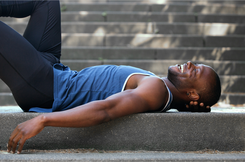
Having a back that doesn’t keep you from doing things you love, is a goal most who have had back problems place at the top of their list.
Of course if you are in the midst of a flare up your more urgent goal may be pain relief,
which is of course understandable!
This blog is aimed at the time period when you are no longer in a flare,
but possibly dealing with some symptoms, and mostly want to get a
healthier back and core so it doesn't happen again.
I see time and again that most people don’t really get the results they are after
when trying to achieve a stronger core and back. We can all
download exercises from the internet, but what really matters
is how you do them and which muscles you are actively recruiting.
So what are your core muscles anyways?
They are your deep stabilizer muscles of the spine, abdominals and pelvic floor.
You can’t necessarily touch them since they lie deep to other muscles and structures.
It’s the same in other joints of the body too - the muscles that lie
closest to the joints are our stabilizers,
not the ones closest to the skin - those are typically our prime movers.
Pain often causes our deep stabilizers to be tense,
guarded and not fire when we need them most.
That’s why using techniques to improve recruitment
as well as the ability to contract and relax at the right time is a key function
of developing a healthier back.
So what are your deep stabilizers?
There are three categories to focus on:
- Deep Abdominals - Transverse Abdominus
- Deep Spinal Stabilizers - Multifidi
- Pelvic Floor Muscles
The catch is that they are not always easy to cue and get them to activate properly
- it’s not like telling yourself to make a muscle with your bicep!
Here are some simple tips:
First start in hook lying - lying on your back with knees bent.
Instead of jumping right into your abdominal exercises take a few minutes
to see how well you are stabilizing.
Place your hands gently on your lower abdomen and lift one foot a few inches off the ground.
Did your abdomen pop up into your hands?
If so, you were not stabilizing well with transverse abdominus.
So imagine what happens when you are doing harder exercises!
Spend some time here learning to control this, and only move on to more
challenging exercises when you can do so at any stage.
To work on this think of gently drawing your navel towards your spine,
then try lifting one foot again.
Next cue is to first draw your pelvic floor up, then navel to the spine, then lift your foot.
You will most likely notice better control of your abdominal wall.
That’s because the deep stabilizers “talk” to each other so using your
ability to cue pelvic floor can help you activate your deep abdominals.
We can more easily cue the pelvic floor muscles since we have the
physiologic function they serve as an easy way to cue them!
The deep spinal muscles are harder to cue but if you are doing the other
two groups that will get you off to a great start!
One cue you can try though is to be in hook lying or side lying and
imagine a guide wire going from either hip bone (ASIS) or your pubic bone
to a point in the lower back
- imagine drawing one of those front points towards your back point.
With all of these techniques, practice activating with control and releasing with control.
It really is a coordination activity that you do as a foundation for any strength work you do!
As far as your yoga practice goes, the same principles apply,
so think about how well you balance front, back and bottom of
your trunk in your poses …. But that’s a whole other blog post…..
I hope you find this helpful! I
If you are in the San Diego area we will be doing all of this live in my
upcoming Back workshop
There are 2 dates available, February and March.
If you are not local, stay tuned for the online version which will be live in a few months.
Be well and don’t hesitate to message me with your questions!
